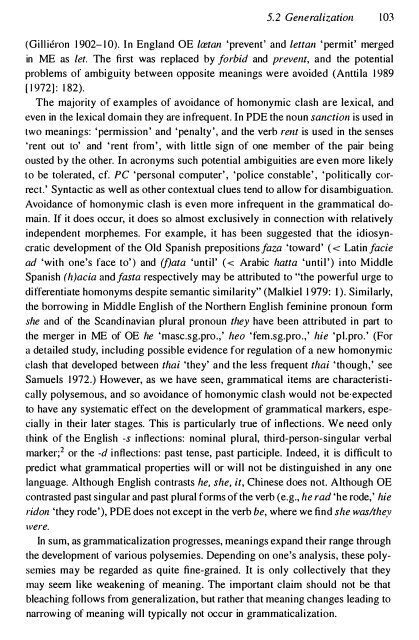Gram - SEAS
Gram - SEAS
Gram - SEAS
You also want an ePaper? Increase the reach of your titles
YUMPU automatically turns print PDFs into web optimized ePapers that Google loves.
5. 2 Generalization 103<br />
(Gillieron 1902- 10). In England OE l(Etan 'prevent' and lettan 'permit' merged<br />
in ME as let. The first was replaced by fo rbid and prevent, and the potential<br />
problems of ambiguity between opposite meanings were avoided (Anttila 1989<br />
[1972]: 182).<br />
The majority of examples of avoidance of homonymic clash are lexical, and<br />
even in the lexical domain they are infrequent. In PDE the noun sanction is used in<br />
two meanings: 'permission' and 'penalty', and the verb rent is used in the senses<br />
'rent out to' and 'rent from', with little sign of one member of the pair being<br />
ousted by the other. In acronyms such potential ambiguities are even more likely<br />
to be tolerated, cf. PC 'personal computer', 'police constable', 'politically correct.'<br />
Syntactic as well as other contextual clues tend to allow for disambiguation.<br />
Avoidance of homonymic clash is even more infrequent in the grammatical domain.<br />
If it does occur, it does so almost exclusively in connection with relatively<br />
independent morphemes. For example, it has been suggested that the idiosyncratic<br />
development of the Old Spanish prepositions faza 'toward' « Latin facie<br />
ad 'with one's face to') and (f)ata 'until' « Arabic hatta 'until') into Middle<br />
Spanish (h)acia andfasta respectively may be attributed to "the powerful urge to<br />
differentiate homonyms despite semantic similarity" (Malkiel 1979: I). Similarly,<br />
the borrowing in Middle English of the Northern English feminine pronoun form<br />
she and of the Scandinavian plural pronoun they have been attributed in part to<br />
the merger in ME of OE he 'masc.sg.pro.,' heo 'fem.sg.pro.,' hie 'pl.pro.' (For<br />
a detailed study, including possible evidence for regulation of a new homonymic<br />
clash that developed between thai 'they' and the less frequent thai 'though,' see<br />
Samuels 1972.) However, as we have seen, grammatical items are characteristically<br />
polysemous, and so avoidance of homonymic clash would not be expected<br />
to have any systematic effect on the development of grammatical markers, especially<br />
in their later stages. This is particularly true of inflections. We need only<br />
think of the English -s inflections: nominal plural, third-person-singular verbal<br />
markel} or the -d intlections: past tense, past participle. Indeed, it is difficult to<br />
predict what grammatical properties will or will not be distinguished in any one<br />
language. Although English contrasts he. she. it, Chinese does not. Although OE<br />
contrasted past singular and past plural forms of the verb (e.g., he rad 'he rode,' hie<br />
ridofl 'they rode'), PDE does not except in the verb be, where we find she was/they<br />
were.<br />
In sum, as grammaticalization progresses, meanings expand their range through<br />
the development of various polysemies. Depending on one's analysis, these polysemies<br />
may be regarded as quite fine-grained. It is only collectively that they<br />
may seem like weakening of meaning. The important claim should not be that<br />
bleaching follows from generalization, but rather that meaning changes leading to<br />
narrowing of meaning will typically not occur in grammaticalization.
















